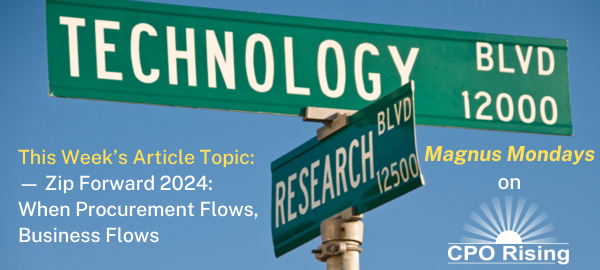Last week I had the pleasure of attending Zip’s annual user conference Zip Forward. It was hosted at the iconic SF Jazz in central San Francisco. It marked my second visit to SF Jazz since attending ScoutRFP’s conference Spark back in 2019.
It’s clear that Zip has continued its rapid growth, and the conference had over 400 attendees, filling up the SF Jazz nicely. The intake and procurement process orchestration (IM&PPO) pioneer now has over 450 customers. And even if many of them are smaller companies, Zip is attracting more and more large enterprise customers exemplified by speakers such as Oliver Gall from Prudential and Brad Pittman from Dollar Tree.
The conference kicked off with the reveal of Zip’s new re-imagined brand, designed to better differentiate Zip as well as better reflect the company’s “commitment to helping businesses reach peak performance and unblock the flow of innovation.” It was followed by some product-centric presentations around three themes for future-proof procurement, scalability, user centricity, and ROI-driven strategies. While there were no major new product announcements (like last year when Zip introduced Zip Sourcing), it did announce three new product capabilities:
- Preferred supplier purchasing. Improved unified search and catalog purchasing capabilities to drive more spend to the preferred suppliers.
- AI invoice coding. Automatic coding of invoices based on historic data.
- Budget integration. Budget integration with Workday Adaptive planning.
These types of product improvements might not be highly innovative, but they are necessary as Zip moves beyond just IM&PPO into also supporting basic S2P capabilities. That said, Zip’s relentless focus on the end user means that it is not (yet) as focused on the professional procurement user, meaning that more advanced S2C capabilities are still lacking. Zip is aware of this and is only positioning themselves as a S2P-type option for small and midmarket organizations.
For the bigger enterprises, the focus is still on IM&PPO or a hybrid approach where Zip’s S2P capabilities are used alongside more established suite providers (e.g., Zip sourcing might be used for simpler sourcing events, etc.). This hybrid approach is interesting, and I think it’s fair to say that as Zip matures, it will be able to replace more and more of the traditional S2P solutions in increasingly larger organizations while allowing (or even enabling) these organizations to keep or add specialized solutions as needed.
All that aside, I picked up on three themes that I found interesting across the presentations and discussions with attendees.
The Need for Agility and Adaptability
As our own research shows, the uncertainty in the supply markets requires more agility and adaptability. Being able to set up new workflows to deal with new types of requests, reviews, or approvals is more important than ever, and you don’t want to have to rely (and wait) on the solution provider or a consultant to help you create these. You need self-service, no-code capabilities to refine or add new workflows as you go. This type of capability is not unique to Zip, but this adaptability was highlighted by a couple of attendees I spoke to. This also leads us to the next theme.
Tech As an Enabler of New Operating Models
While this seems obvious, the complexity of implementing many legacy enterprise applications means that the focus has shifted from how things should be done to the technical details of setting up a solution. Making solutions easier and faster to deploy allows purchasing organizations to focus more on how to operate and how technology can help manage spend, drive compliance, and engage stakeholders. A likely side effect is that the system integrators and implementation partners will need to change how they work with the newer generation of solution providers in the market (and their customers), but that’s a different discussion.
Increased Focus on Stakeholder Engagement
A couple of the sessions at Zip Forward talked about the need to engage more with non-procurement stakeholders. Both because of more stringent policy requirements but also because of managing more complex spend categories. On top of this, we’ve known for years that early involvement in sourcing projects is a critical success factor for the outcome of the project. So, providing clear and easy to use ways for the stakeholders to engage with procurement has become a must have rather than a nice to have capability.
Given the nature of Zip and its offering, it’s perhaps not surprising that these types of things were front and center of the presentations. But that does not make them less relevant, and it shows that there is still room for innovation and improvement in how procurement organizations operate and leverage technology.
RELATED RESEARCH
Magnus Mondays: Zip — One App to Rule Them All?
Will 2024 be the “Year of Intake Management and Procurement Process Orchestration?”


